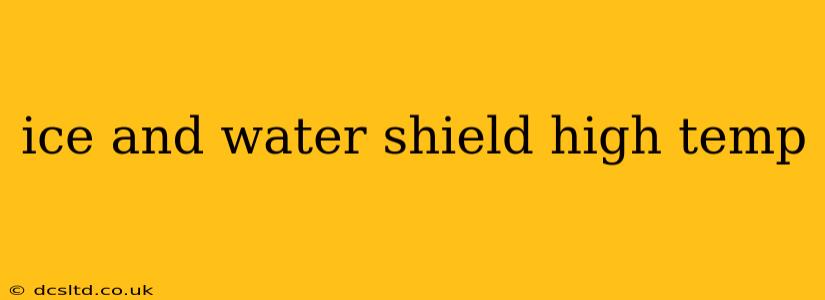Ice and Water Shield (IWS) is a crucial component in roofing systems, providing a critical layer of protection against water damage. However, its performance can be affected by extreme temperatures. This guide delves into the high-temperature capabilities of IWS, addressing common concerns and providing valuable insights for professionals and homeowners alike.
What is Ice and Water Shield?
Ice and Water Shield is a self-adhering, waterproof underlayment designed to protect vulnerable areas of a roof from ice dams, wind-driven rain, and leaks. It's typically installed under the roofing shingles in valleys, around chimneys, and at the eaves and rakes – areas particularly susceptible to water intrusion. Different manufacturers offer variations, but the core function remains the same: to provide an extra layer of defense against moisture damage.
Does Ice and Water Shield Have a High-Temperature Limit?
This is a crucial question. The answer isn't a single, universally applicable temperature. The high-temperature performance of IWS is dependent on several factors including:
- The specific manufacturer and product: Each manufacturer's IWS has its own specifications regarding temperature resistance. Always consult the manufacturer's data sheet for the exact temperature limits of the product you are using.
- Installation method: Correct installation is critical for optimal performance at high temperatures. Improper installation can compromise the adhesion and waterproofing capabilities of the membrane.
- Exposure duration: Prolonged exposure to extreme heat can degrade even the most durable IWS. Short-term exposure to temperatures exceeding the manufacturer's recommendations might not cause immediate failure, but repeated exposure could lead to problems.
- Underlying roofing materials: The materials beneath the IWS can also influence its response to high temperatures.
In short: There isn't a single "high-temperature limit" for all Ice and Water Shields. Always refer to the manufacturer's specifications.
What Happens to Ice and Water Shield in High Temperatures?
Excessively high temperatures can cause several issues with IWS:
- Reduced adhesion: Extreme heat can weaken the adhesive, potentially causing the IWS to peel away from the roof deck.
- Material degradation: Prolonged exposure to high temperatures can cause the IWS material to become brittle, reducing its flexibility and waterproofing capabilities.
- Increased risk of failure: A compromised IWS is more susceptible to damage from water penetration, leading to costly repairs.
How to Protect Ice and Water Shield from High Temperatures During Installation?
- Schedule installation carefully: Avoid installing IWS during the hottest part of the day. Early mornings or late afternoons are generally preferable.
- Use proper ventilation: Ensure adequate ventilation in the attic to prevent heat buildup beneath the roofing system.
- Follow manufacturer's instructions: Adhere strictly to the manufacturer's guidelines regarding installation, including surface preparation and application methods.
What are the temperature ranges for various Ice and Water Shield products? (Addressing a PAA question)
Unfortunately, I cannot provide specific temperature ranges for various IWS products. This information is proprietary to each manufacturer and varies depending on the specific product formulation. Always consult the manufacturer's technical data sheet for the exact temperature range and other crucial installation details for the specific Ice and Water Shield product you are using.
Can I use Ice and Water Shield in hot climates? (Addressing a PAA question)
Yes, IWS can be used in hot climates, but it's crucial to select a product specifically designed for such conditions and to follow the manufacturer's installation guidelines meticulously. Consider using IWS with higher temperature resistance ratings if you live in a region known for extreme heat. Proper ventilation in the attic space also becomes even more important in hot climates.
What are the signs of Ice and Water Shield failure due to heat? (Addressing a PAA question)
Signs of high-temperature related IWS failure may include:
- Peeling or bubbling: The IWS may start to peel away from the roof deck, exhibiting blisters or bubbles.
- Brittle material: The membrane may appear brittle and lose its flexibility.
- Cracks or tears: The IWS may develop cracks or tears, compromising its waterproof barrier.
- Visible water damage: Ultimately, water damage to the underlying sheathing or roof structure may become apparent.
Conclusion: Prioritize Manufacturer Guidelines
The effectiveness of Ice and Water Shield under high-temperature conditions depends heavily on choosing the right product and adhering strictly to the manufacturer's recommendations. Always consult the specific product data sheet for the most accurate information on temperature limits, installation procedures, and potential issues. Remember, preventative measures during installation are key to ensuring long-term performance and protection against water damage.
